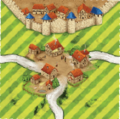The Farmers
General info and comments
Farmers are considered a part of the base game for most of the Carcassonne players. They are also used in every official tournament as they are not considered an expansion. In new edition of Carcassonne farmers where separated as a supplement to ease approach to the game for new players. WikiCarpedia follows this streamlined approach. Still for the sake of other expansions and the rest of the WikiCarpedia, farmers are considered a part of the base game.
What would life be without agriculture? We try to answer part of this question by introducing the hard-working farmers who spend long hours in the fields of Carcassonne. As we did for the roads, cities, and monasteries, the farmers will be presented using the actions of a game turn.
Contents
- None. Only contents of base game are used.
Rules
Placing a tile
As you are now used to, you must place your tile in such a way that it continues the landscape and illustration. Fields always refer to the green spaces found in the landscape of Carcassonne.
Placing a meeple as a farmer
A farmer is a meeple that you place “laying down” in a field segment. “Laying down?” Yes. Unlike highwaymen, knights, and monks that are all placed standing up, farmers are laid down on a tile because they are only scored at the end of the game. Consequently, they are not returned to your supply after scoring. Laying farmers down ensures that you remember to leave them on the board. As always, you can only place your farmer if there are no other farmers in the field. The fields of Carcassonne are divided by roads and cities. Pictured below are three separate fields.
Scoring fields
As mentioned previously, farmers are not scored during the game and, consequently, they do not return to your supply. So place your farmers wisely. Now, let’s assume the game is over and that we are conducting the final scoring. Unlike other features, it is not the field tiles that are counted, but the number of completed cities that border a field. Each completed city that touches a field adds 3 points to the value of that field. All fields touched by a city will see their value increased by 3 points.

Summary
You now know how to play with farmers! Here is a summary of the most important rules concerning farmers:
- Farmers are placed “laying down” on the board.
- Farmers are only scored during the final scoring.
- Each completed city adjacent to a field you occupy gives you 3 points.
- As is the case with roads and cities, there may be more than one farmer in the same field.
- Once again, the same scoring rules apply to farmers. Only the player with the most farmers in a fields scores the points for that field. In case of a tie, the tied players each score full points.

